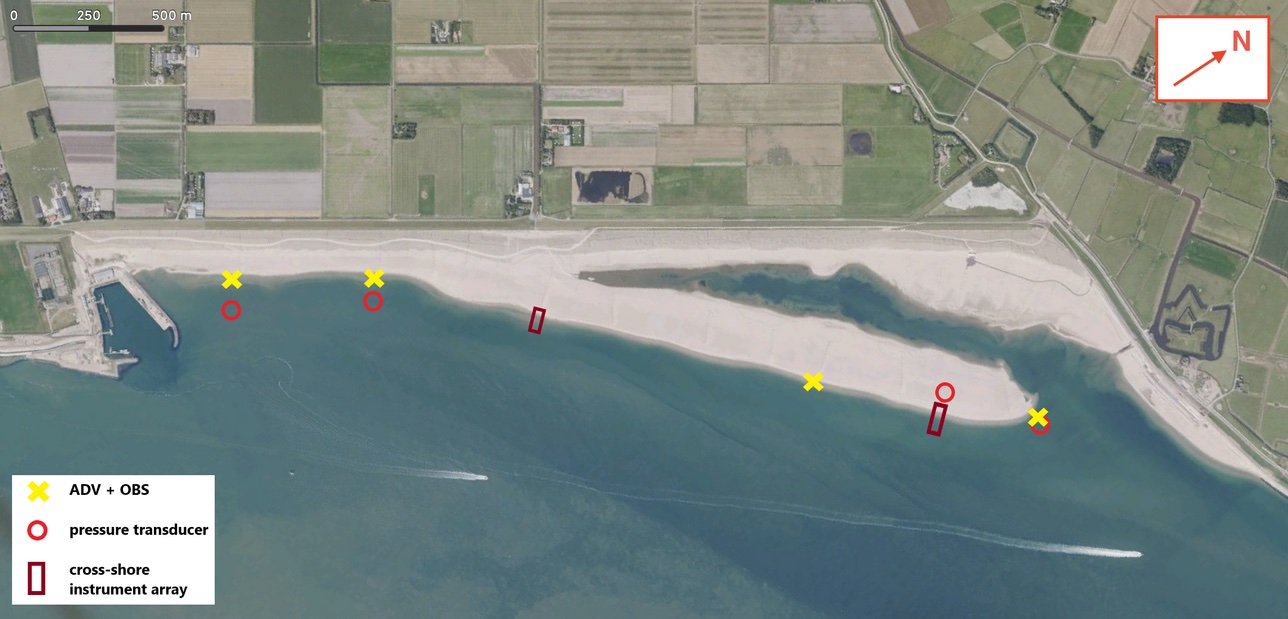J.W. Bosma1*, M. klein Obbink1, J.B. Woerdman1, R. Hoegen1, M.A. van der Lugt2, T.D. Price1
1 Utrecht University
2 Delft University of Technology
*corresponding author:
Introduction
Sand nourishments are increasingly applied to more sheltered systems (e.g., Perk et al., 2019), where the morphodynamics are driven by mixed (tides and waves) forcing. Here, sand deposits are usually retrofitted to inadequate, hard flood defences to act as a buffer against erosion of such infrastructure. Introducing different grain sizes into a system results in more complex, differentiated sediment transport, as coarser fractions are mobilised at different moments and places than finer fractions (McCarron et al., 2019). By focussing on a nourishment on the leeward side of a barrier island, we aim to find quantitative answers to the questions when and how the mixed-sediment composition changes and what implications that has for the morphologic evolution of the area.
Methods
This research is based on the 6-week SEDMEX field campaign in autumn 2021 at the 3-km long Prins Hendrikzanddijk, a retrofit nourishment on the island of Texel (Fig. 1). We deployed long- and cross-shore arrays of instruments (Fig. 1) that measured a range of parameters such as pressure, flow velocity, suspended sediment concentration and bedforms. These measurements were further complemented by almost daily bed-level measurements and spatiotemporally extensive sets of sediment samples.
Results
Wave heights (Hm0) ranged up to 0.6 m, while tidal currents frequently reached velocities up to 0.5 m/s. Wide grain-size distributions, sometimes revealing multi-modality, characterised the top 5-6 cm of the bed almost everywhere. The D50 varied temporally and spatially, both in the cross- and longshore directions, often hand in hand with changes in bed level and beach-step position after a period of increased wave activity. Furthermore, transient patterns of surfacing coarse and shell-rich material often characterised the intertidal beach surface. We will further elaborate on our findings at the conference.

Figure 1: The Prins Hendrikzanddijk with the instrument locations during the SEDMEX campaign.
References
McCarron, C.J., Van Landeghem, K.J.J., Baas, J.H., Amoudry, L.O., Malarkey, J., 2019. The hiding-exposure effect revisited: A method to calculate the mobility of bimodal sediment mixtures. Mar. Geol. 410, 22–31. https://doi.org/10.1016/j.margeo.2018.12.001
Perk, L., van Rijn, L., Koudstaal, K., Fordeyn, J., 2019. A rational method for the design of sand dike/dune systems at sheltered sites; Wadden Sea Coast of Texel, The Netherlands. J. Mar. Sci. Eng. 7. https://doi.org/10.3390/jmse7090324
I. Surname1*, F.N. Another-Surname2 , Y. Next-Surname2
1 University Name, Country; 2 Organization Name, Country
* Corresponding author: mail.name@organization.org


